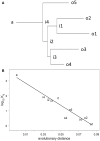Reconstructing a B-Cell Clonal Lineage. II. Mutation, Selection, and Affinity Maturation
- PMID: 24795717
- PMCID: PMC4001017
- DOI: 10.3389/fimmu.2014.00170
Reconstructing a B-Cell Clonal Lineage. II. Mutation, Selection, and Affinity Maturation
Abstract
Affinity maturation of the antibody response is a fundamental process in adaptive immunity during which B-cells activated by infection or vaccination undergo rapid proliferation accompanied by the acquisition of point mutations in their rearranged immunoglobulin (Ig) genes and selection for increased affinity for the eliciting antigen. The rate of somatic hypermutation at any position within an Ig gene is known to depend strongly on the local DNA sequence, and Ig genes have region-specific codon biases that influence the local mutation rate within the gene resulting in increased differential mutability in the regions that encode the antigen-binding domains. We have isolated a set of clonally related natural Ig heavy chain-light chain pairs from an experimentally infected influenza patient, inferred the unmutated ancestral rearrangements and the maturation intermediates, and synthesized all the antibodies using recombinant methods. The lineage exhibits a remarkably uniform rate of improvement of the effective affinity to influenza hemagglutinin (HA) over evolutionary time, increasing 1000-fold overall from the unmutated ancestor to the best of the observed antibodies. Furthermore, analysis of selection reveals that selection and mutation bias were concordant even at the level of maturation to a single antigen. Substantial improvement in affinity to HA occurred along mutationally preferred paths in sequence space and was thus strongly facilitated by the underlying local codon biases.
Keywords: antibody affinity maturation; antibody selection; experimental influenza infection; phylogenetics; somatic hypermutation.
Figures





Similar articles
-
The mutation patterns in B-cell immunoglobulin receptors reflect the influence of selection acting at multiple time-scales.Philos Trans R Soc Lond B Biol Sci. 2015 Sep 5;370(1676):20140242. doi: 10.1098/rstb.2014.0242. Philos Trans R Soc Lond B Biol Sci. 2015. PMID: 26194756 Free PMC article.
-
Affinity maturation in a human humoral response to influenza hemagglutinin.Proc Natl Acad Sci U S A. 2019 Dec 26;116(52):26745-26751. doi: 10.1073/pnas.1915620116. Epub 2019 Dec 16. Proc Natl Acad Sci U S A. 2019. PMID: 31843892 Free PMC article.
-
Somatic diversification and selection of immunoglobulin heavy and light chain variable region genes in IgG+ CD5+ chronic lymphocytic leukemia B cells.J Exp Med. 1995 Apr 1;181(4):1507-17. doi: 10.1084/jem.181.4.1507. J Exp Med. 1995. PMID: 7535340 Free PMC article.
-
Somatic hypermutation and B-cell lymphoma.Philos Trans R Soc Lond B Biol Sci. 2001 Jan 29;356(1405):73-82. doi: 10.1098/rstb.2000.0751. Philos Trans R Soc Lond B Biol Sci. 2001. PMID: 11205334 Free PMC article. Review.
-
Structure and function of natural antibodies.Curr Top Microbiol Immunol. 1996;210:167-79. doi: 10.1007/978-3-642-85226-8_17. Curr Top Microbiol Immunol. 1996. PMID: 8565555 Review.
Cited by
-
Immune system modeling and analysis.Front Immunol. 2014 Dec 19;5:644. doi: 10.3389/fimmu.2014.00644. eCollection 2014. Front Immunol. 2014. PMID: 25566257 Free PMC article. No abstract available.
-
Antigenic sin and multiple breakthrough infections drive converging evolution of COVID-19 neutralizing responses.Cell Rep. 2024 Sep 24;43(9):114645. doi: 10.1016/j.celrep.2024.114645. Epub 2024 Aug 27. Cell Rep. 2024. PMID: 39207904 Free PMC article.
-
Strategies for HIV-1 vaccines that induce broadly neutralizing antibodies.Nat Rev Immunol. 2023 Mar;23(3):142-158. doi: 10.1038/s41577-022-00753-w. Epub 2022 Aug 12. Nat Rev Immunol. 2023. PMID: 35962033 Free PMC article. Review.
-
Functional Relevance of Improbable Antibody Mutations for HIV Broadly Neutralizing Antibody Development.Cell Host Microbe. 2018 Jun 13;23(6):759-765.e6. doi: 10.1016/j.chom.2018.04.018. Epub 2018 May 31. Cell Host Microbe. 2018. PMID: 29861171 Free PMC article.
-
mRNA vaccines and hybrid immunity use different B cell germlines against Omicron BA.4 and BA.5.Nat Commun. 2023 Mar 28;14(1):1734. doi: 10.1038/s41467-023-37422-y. Nat Commun. 2023. PMID: 36977711 Free PMC article.
References
Grants and funding
LinkOut - more resources
Full Text Sources
Other Literature Sources

